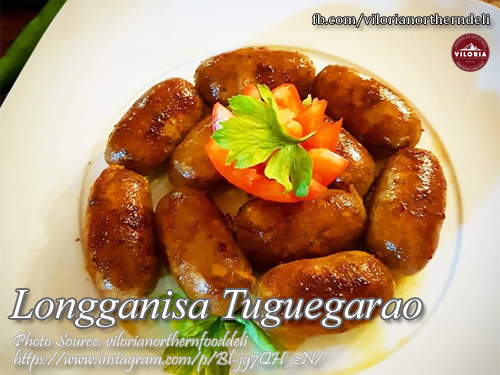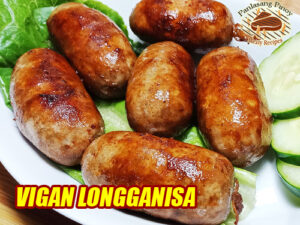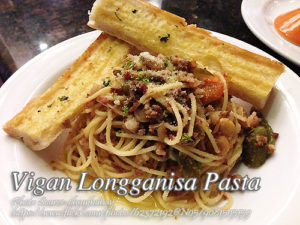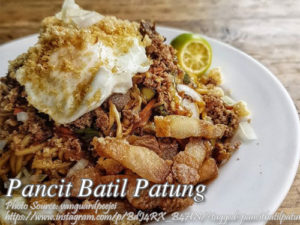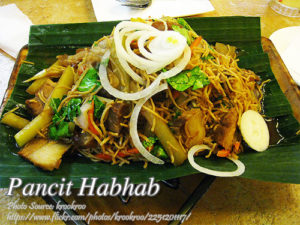This longganisa Tuguegarao is a non-sweet type, salty and garlicky longganisa very similar to Vigan longganisa or Lucban longganisa. It is also known as longganisang Ybanag and it is famous in the region of Cagayan Valley. When making your own longganisa or sausages, it is better if your have your own meat grinder so you can grind the correct type of meat and the proportion of lean meat to the fat.
It is very important to use this technique if you want to make your longganisa either lean or with right amount of pork fat. In making longganisa or sausages, there should be at least 30 percent fat and it should be coarsely chopped or ground. If not coarsely ground, the fat will easily soften and you will have a hard hard time stuffing it into the hog casing specially if you are using a funnel or a meat grinder with a sausage stuffer nozzle. The fat will also make your longganisa tender and juicy whereas the very lean longganisa is very dry and hard.
A Nostalgic Taste of Home: Longganisa Tuguegarao
I am transported to the times of my family gathered around the kitchen, cooking meals, whenever I cook a batch of longganisa from Tuguegarao. And the recipes reek of culture in them. This is one dish that really reminds me of my warm home and closer bonding with relatives, seeing as it’s something my relatives have been preparing for generations. This longganisa, colloquially known as longganisang Ybanag, is considered to be the most delicious of its kind because it comes out deep, savory-tasting, being a product born of the authentic Cagayan Valley.
Unlike its sweet-style cousins in other parts of the country, the Tuguegarao version centers more on salt, garlic, and fat in perfect harmony, giving one a robust taste that does not need sweetness. It’s like other more famous ones like Vigan and Lucban longganisa, but there’s something special about it being there for me.
A Perfect Recipe for Longganisa: Lesson from the Family Home
I learned this recipe from my uncle. He was one of the most skillful people who know exactly what to expect with the right mixture of meat and fat that gives it that soft and juicy finish. Advice? Invest in a good meat grinder. That is the way it is with his sitting in the back, chilling pork for hours, explaining how cold meat is easier to handle and gives you more control when grinding. That matters too-the type of grind, that is: coarsely ground meat holds the fat together, so the sausage would be juicy and not dry or tough. He’d always say, “Never rush this part if you want your longganisa to turn out right.”
It is an art, really. Ideal longganisa content should be around 30 percent fat-it’s rather fatty-sounds a little wrong, doesn’t it? Actually, this fat is what will keep the sausage nice and soft; it also makes stuffing into hog casing an easier process. Many people grind the fat too finely and melt way too much faster, making stuffing just that little bit harder. My uncle always filled the casing using a funnel or a sausage stuffer nozzle, and one could only see the way things come into place smoothly when the technique was right.
The Heart of Cagayan Valley in Every Bite
There’s something about the cuisine in Cagayan Valley that makes you see the connection to the land. Maybe it’s just the simple composition of ingredients or maybe each dish has a story behind it. Whatever the case may be, the longganisa from Tuguegarao definitely is no exemption. Overpowered by its cousins from Vigan and Lucban, it holds its own with its rich garlicky flavor and prominent texture. In many ways, it’s like the people in the region: straight and simple, hearty, and with a flavor that lingers.
I remember that some years ago, my sister came back from her trip to Cagayan with bundles of this renowned sausage from that place. And so, gathered in the kitchen, we boiled them, just as she had learned from the locals – once the water dries, we would fry it until golden brown. The smell alone gathers everyone to savor the taste of home. Simple fare: served with rice, perhaps accompanied by tomatoes on the side, but it was intensely happy-making.
The Fat Revolution: Why Lean Isn’t Always Better
When I was young, I thought the leaner the meat the better and healthier it would be. The experience of making these sausages has made me see why. Now, the fats are really an essential role in this longganisa. If there is no sufficient amount of it, the longganisa may turn out dry and crumbly. Nobody wants that. My uncle jokes that fat is the secret ingredient, the thing that makes indulgent and satisfying this particular dish.
If you ever have the urge to make your own sausage, especially this type, never scrimp on the fat. My family always wants that perfect percentage, 30 percent fat, and it’s worth it. It’s not greasing out some dish; it’s just supplying that silky, melt-in-your-mouth that’s characteristic of a great sausage. Trust me, you’re going to love the richness it brings into every mouthful.
A Traditional Dish
It is more than a little exercise in the kitchen to make this sausage. It’s to pay homage to a legacy that’s been passed down for generations. Each time I am making a batch, I think of my great-grandmother, my great-grandfather, or possibly even great-great-grandmother and father who perhaps stood in their own kitchens grinding the meat by hand, mixing the spices, and stuffing the casings much in the way I do now. It is a way of bonding to my roots, the land that my family hails from, and the flavors that took shape on family dinner plates.
Cooking the Perfect Longganisa at Home
Cooking these sausages is actually easy; all you have to do is everything you need to prepare. Just a little water in the pan, simmer until the liquid dries, and then fry in a little oil until their skins crisp up beautifully. That is how my sister taught me and since then, that’s the way I have been cooking. When the sausages sizzle in the pan, which then emits the fragrant garlic savory smell; one feels reminded of those lovely family meals and the taste of home comfort.
Whether served over garlic rice, topped with a fried egg, or even part of a filling brunch, it’s one of those meals that can bring people together. Preparing this is work-intensive, but oh so worth it at the end. So when the urge for something a little different from the usual sweet-style longganisa comes on, try this Tuguegarao version. It’s food, but it is history, tradition, and a connection to something much deeper.
How to Make Longganisa Tuguegarao
Ingredients
- 1 kilo pork coursely ground (ideally with 30% fat)
- 1 Tbsp. ground pepper
- 2 heads garlic chopped
- 1 Tbsp salt
- 3 Tbsp sukang Iloko
- 1 1/2 Tbsp oil cooked with 1 Tbsp. achuete seeds discard the seeds
- hog casings
- cooking twine
Instructions
How to make Longganisa Tuguegarao:
- If you are grinding the pork using a meat grinder, chill the pork for a few hours then chop into small pieces that will fit in the meat grinder.
- Grind the pork coursely using a large hole meat grinder blade (5mm hole) and grind the pork.
- Combine all the ingredients in a bowl. Mix until all the ingredients are well combined.
- Using a sausage stuffer or a funnel, insert the first end of the hog casing on the funnel and fill it with the meat mixture. Divide the longganisa into 2 to 3 inch links by twisting and tie with strings.
- Hang the longganisa and air dry for a few hours. Then store it in the freezer. To cook the longganisa, put a small amount of water in a pan and boil unit the liquid evaporates. Then fry with a some cooking oil until brown.
Notes
Cooking Tips:
Use Coarsely Ground Pork for Best Texture
To achieve a good balance of tenderness and juiciness, coarse grind on pork is required. If the pork is finely ground, the sausage becomes too soft. Thus, fat melts a little too quickly, losing the Sisig character. It is texture that holds good shape in cooking with longganisa.Chill the Pork Before Grinding
This will grind the pork chilled, which helps to keep the fat firm and more manageable. Cold meat also grinds much more evenly and prevents the fat from becoming too soft, relating to proper texture; it also makes the stuffing of the casing an easier process.Don't skip the drying process
Air-dried for several hours after stuffing gives longganisa an opportunity to develop flavor and helps casing stiffen up. This step also dries it to cook better, and would not become too greasy when it is not fried properly. This helps ensure that, when you do fry it, the casing will get crispy.
